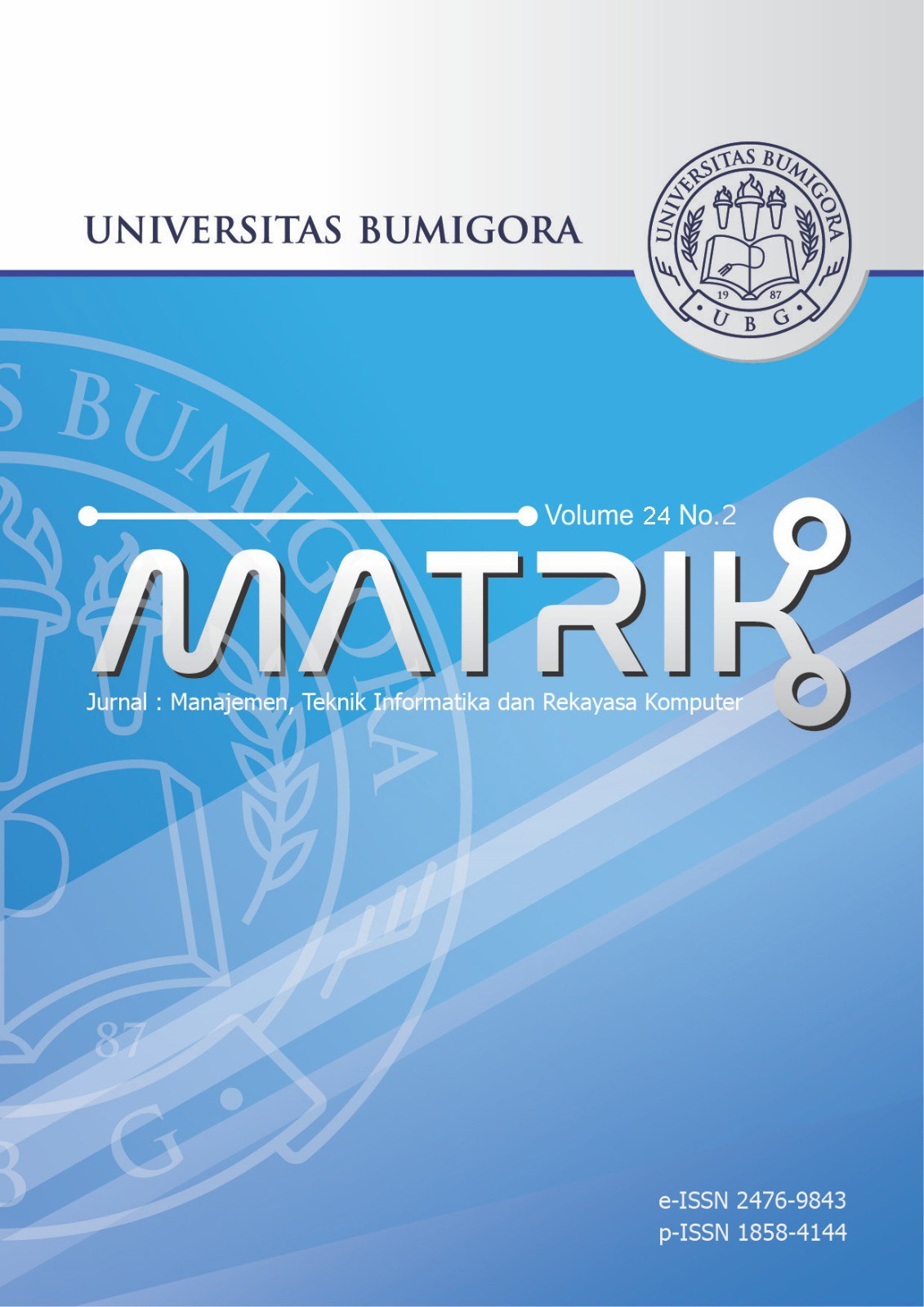Optimization of Content Recommendation System Based on User Preferences Using Neural Collaborative Filtering
DOI:
https://doi.org/10.30812/matrik.v24i2.4775Keywords:
Cold-Start, Data Sparsity, Hyperparameter Tuning, Neural Collaborative Filtering, Recommendation SystemAbstract
Recommender systems play a crucial role in enhancing user experience across various digital platforms by delivering relevant and personalized content. However, many recommender systems still face challenges in providing accurate recommendations, especially in cold-start situations and when user data is limited. This study aims to address these issues by optimizing content recommendation systems using Neural Collaborative Filtering (NCF), a deep learning-based approach capable of capturing non-linear relationships between users and items. We compare the performance of NCF with traditional methods such as Matrix Factorization (MF) and Content-Based Filtering (CBF) using the MovieLens-1M dataset. The research method employed is a quantitative approach that encompasses several stages, including preprocessing, model training, and evaluation using metrics such as Root Mean Squared Error (RMSE) and Precision@K. The results of this research are significant, demonstrating that NCF achieves the lowest RMSE of 0.870, outperforming MF with an RMSE of 0.950 and CBF with an RMSE of 1.020. Additionally, the Precision@K achieved by NCF is 0.73, indicating the model’s superior ability to provide more relevant recommendations compared to baseline methods. Hyperparameter tuning reveals that the optimal combination includes an embedding size of 16, three hidden layers, and a learning rate of 0.005. Despite its excellent performance, NCF still faces challenges in handling cold-start cases and requires significant computational resources. To address these challenges, integrating additional metadata and exploring regularization techniques such as dropout are recommended to enhance generalization. The implications of the findings from this study suggest that NCF can significantly improve prediction accuracy and recommendation relevance, thus having the potential for widespread application across various domains, such as e-commerce, streaming services, and education, to enhance user experience and the efficiency of recommendation systems. Further research is needed to explore innovative solutions to address cold-start challenges and reduce computational demands.
Downloads
References
Platform E-Commerce dan Media Sosial Terhadap Masyarakat Dalam Melakukan Pembelian,†vol. 5, no. 1, pp. 63–72,
https://doi.org/10.47065/tin.v5i1.5293.
[2] B. G. Sudarsono, M. I. Leo, A. Santoso, and F. Hendrawan, “Analisis Data Mining Data Netflix Menggunakan Aplikasi Rapid
Miner,†vol. 4, no. 1, https://doi.org/10.30813/jbase.v4i1.2729.
[3] R. Lumbantoruan, P. Simanjuntak, I. Aritonang, and E. Simaremare, “TopC-CAMF: A Top Context-Based Matrix Factorization
Recommender System,†vol. 11, no. 4, pp. 258–266, https://doi.org/10.22146/jnteti.v11i4.5399.
[4] H. Hartatik and R. Rosyid, “Pengaruh User Profiling pada Rekomendasi Sistem Menggunakan K-Means dan KNN,†vol. 2,
no. 1, pp. 13–18, https://doi.org/10.24076/JOISM.2020v2i1.199.
[5] R. R. Mahendra, F. T. Anggraeny, and H. E. Wahanani, “Implementasi Item-based Collaborative Filtering untuk Rekomendasi
Film,†vol. 2, no. 3, pp. 213–221, https://doi.org/10.62951/repeater.v2i3.140.
[6] M. R. Waskito, A. D. Rahajoe, and A. L. Nurlaili, “Implementasi Metode Collaborative Filtering Menggunakan Algoritma
Cosine Similarity dan Jaccard Similarity pada Sistem E-commerce,†vol. 12, https://doi.org/10.23960/jitet.v12i3S1.5315.
[7] T. Ridwansyah, B. Subartini, and S. Sylviani, “Penerapan Metode Content-Based Filtering pada Sistem Rekomendasi,†vol. 4,
no. 2, pp. 70–77, https://doi.org/10.22437/msa.v4i2.32136.
[8] H. D. Putri and M. Faisal, “Analyzing the Effectiveness of Collaborative Filtering and Content-Based Filtering Methods in
Anime Recommendation Systems,†vol. 7, no. 2, pp. 124–133, https://doi.org/10.31603/komtika.v7i2.9219.
[9] R. Faurina and E. Sitanggang, “Implementasi Metode Content-Based Filtering dan Collaborative Filtering pada Sistem
Rekomendasi Wisata di Bali,†vol. 22, no. 4, pp. 870–881, https://doi.org/10.33633/tc.v22i4.8556.
[10] Y. I. Lubis, D. J. Napitupulu, and A. S. Dharma, “Implementasi Metode Hybrid Filtering ( Collaborative dan Content-based)
untuk Sistem Rekomendasi Pariwisata Implementation of Hybrid Filtering (Collaborative and Content-based) Methods for the
Tourism Recommendation System.†Departemen Teknik Elektro dan Teknologi Informasi UGM, pp. 28–35, https://citee.ft.
ugm.ac.id/download51.php?f=TI-5%20-%20Implementasi%20Metode%20Hybrid%20Filtering.pdf.
[11] V. C. Silva, B. Gorgulho, D. M. Marchioni, S. M. Alvim, L. Giatti, T. A. De Araujo, A. C. Alonso, I. D. S. Santos, P. A.
Lotufo, and I. M. Bense˜nor, “Recommender System Based on Collaborative Filtering for Personalized Dietary Advice: A
Cross-Sectional Analysis of the ELSA-Brasil Study,†vol. 19, no. 22, p. 14934, https://doi.org/10.3390/ijerph192214934.
[12] M. A. Pradana and A. T. Wibowo, “Movie Recommendation System Using Hybrid Filtering with Word2Vec and Restricted
Boltzmann Machines,†vol. 9, no. 1, pp. 231–241, https://doi.org/10.29100/jipi.v9i1.4306.
[13] M. Srifi, A. Oussous, A. Ait Lahcen, and S. Mouline, “Recommender Systems Based on Collaborative Filtering Using Review
Texts—A Survey,†vol. 11, no. 6, p. 317, https://doi.org/10.3390/info11060317.
[14] D. Roy and M. Dutta, “A systematic review and research perspective on recommender systems,†vol. 9, no. 1, pp. 1–36,
https://doi.org/10.1186/s40537-022-00592-5.
[15] J.-Y. Kim and C.-K. Lim, “Feature Extracted Deep Neural Collaborative Filtering for E-Book Service Recommendations,â€
vol. 13, no. 11, p. 6833, https://doi.org/10.3390/app13116833.
[16] M. Aldayel, A. Al-Nafjan, W. M. Al-Nuwaiser, G. Alrehaili, and G. Alyahya, “Collaborative Filtering-Based
Recommendation Systems for Touristic Businesses, Attractions, and Destinations,†vol. 12, no. 19, p. 4047,
https://doi.org/10.3390/electronics12194047.
[17] B. Fan, L. Sun, D. Tan, and M. Pan, “Optimal Selection Technology of Business Data Resources for Multi-Value Chain Data
Space—Optimizing Future Data Management Methods,†vol. 13, no. 23, p. 4690, https://doi.org/10.3390/electronics13234690.
[18] Z. Wang, L. Li, K. He, and Z. Zhu, “User Profile Construction Based on High-Dimensional Features Extracted by Stacking
Ensemble Learning,†vol. 15, no. 3, pp. 1–18, https://doi.org/10.3390/app15031224.
[19] A. E. Butler, M. Nandakumar, T. Sathyapalan, E. Brennan, and S. L. Atkin, “Matrix Metalloproteinases, Tissue Inhibitors of
Metalloproteinases, and Their Ratios in Women with Polycystic Ovary Syndrome and Healthy Controls,†vol. 26, no. 1, p. 321,
https://doi.org/10.3390/ijms26010321.
[20] X. He and J. Wang, “A Hybrid Forecasting System Based on Comprehensive Feature Selection and Intelligent Optimization
for Stock Price Index Forecasting,†vol. 12, no. 23, p. 3778, https://doi.org/10.3390/math12233778.
[21] B. Ersoz, S. Oyucu, A. Aksoz, . Sa˘gıro˘glu, and E. Bic¸er, “Interpreting CNN-RNN Hybrid Model-Based Ensemble Learning
with Explainable Artificial Intelligence to Predict the Performance of Li-Ion Batteries in Drone Flights,†vol. 14, no. 23, p.
10816, https://doi.org/10.3390/app142310816.
[22] S. Lee, J. Ahn, and N. Kim, “Embedding Enhancement Method for LightGCN in Recommendation Information Systems,â€
vol. 13, no. 12, p. 2282, https://doi.org/10.3390/electronics13122282.
[23] H. H. Nuha, S. A. Mugitama, A. A. Absa, and Sutiyo, “K-Nearest Neighbors with Third-Order Distance for Flooding Attack
Classification in Optical Burst Switching Networks,†vol. 6, no. 1, p. 1, https://doi.org/10.3390/iot6010001.
[24] K. Tak´acs, R. V´egh, Z. Medny´anszky, J. Haddad, K. Allaf, M. Du, K. Chen, J. Kan, T. Cai, P. Moln´ar, P. B´arsony,
A. Macz´o, Z. Zal´an, and I. Dalmadi, “New Insights into Duckweed as an Alternative Source of Food and Feed: Key
Components and Potential Technological
Downloads
Published
Issue
Section
How to Cite
Similar Articles
- Arief Hermawan, Adityo Permana Wibowo, Akmal Setiawan Wijaya, The Improvement of Artificial Neural Network Accuracy Using Principle Component Analysis Approach , MATRIK : Jurnal Manajemen, Teknik Informatika dan Rekayasa Komputer: Vol. 22 No. 1 (2022)
- Muhammad Yunus, Optimasi Penentuan Nilai Parameter Himpunan Fuzzy dengan Teknik Tuning System , MATRIK : Jurnal Manajemen, Teknik Informatika dan Rekayasa Komputer: Vol. 18 No. 1 (2018)
- Aini Suri Talita, Aristiawan Wiguna, Implementasi Algoritma Long Short-Term Memory (LSTM) Untuk Mendeteksi Ujaran Kebencian (Hate Speech) Pada Kasus Pilpres 2019 , MATRIK : Jurnal Manajemen, Teknik Informatika dan Rekayasa Komputer: Vol. 19 No. 1 (2019)
- Vivin Nur Aziza, Utami Dyah Syafitri, Anwar Fitrianto, Optimizing Currency Circulation Forecasts in Indonesia: A Hybrid Prophet- Long Short Term Memory Model with Hyperparameter Tuning , MATRIK : Jurnal Manajemen, Teknik Informatika dan Rekayasa Komputer: Vol. 24 No. 1 (2024)
- Helna Wardhana, I Made Yadi Dharma, Khairan Marzuki, Ibjan Syarif Hidayatullah, Implementation of Neural Machine Translation in Translating from Indonesian to Sasak Language , MATRIK : Jurnal Manajemen, Teknik Informatika dan Rekayasa Komputer: Vol. 23 No. 2 (2024)
- Achmad Lukman, Wahju Tjahjo Saputro, Erni Seniwati, Improving Performance Convolutional Neural Networks Using Modified Pooling Function , MATRIK : Jurnal Manajemen, Teknik Informatika dan Rekayasa Komputer: Vol. 23 No. 2 (2024)
- Miftahus Sholihin, Mohd Farhan Bin Md. Fudzee, Lilik Anifah, A Novel CNN-Based Approach for Classification of Tomato Plant Diseases , MATRIK : Jurnal Manajemen, Teknik Informatika dan Rekayasa Komputer: Vol. 24 No. 3 (2025)
- Willy Riyadi, Jasmir Jasmir, Performance Prediction of Airport Traffic Using LSTM and CNN-LSTM Models , MATRIK : Jurnal Manajemen, Teknik Informatika dan Rekayasa Komputer: Vol. 22 No. 3 (2023)
- Putri Jafar, Dolly Indra, Fitriyani Umar, Color Feature Extraction for Grape Variety Identification: Naïve Bayes Approach , MATRIK : Jurnal Manajemen, Teknik Informatika dan Rekayasa Komputer: Vol. 23 No. 3 (2024)
- Roudlotul Jannah Alfirdausy, Nurissaidah Ulinnuha, Wika Dianita Utami, Implementation of The Extreme Gradient Boosting Algorithm with Hyperparameter Tuning in Celiac Disease Classification , MATRIK : Jurnal Manajemen, Teknik Informatika dan Rekayasa Komputer: Vol. 24 No. 1 (2024)
You may also start an advanced similarity search for this article.
Most read articles by the same author(s)
- Lusiana Efrizoni, Sarjon Defit, Muhammad Tajuddin, Anthony Anggrawan, Komparasi Ekstraksi Fitur dalam Klasifikasi Teks Multilabel Menggunakan Algoritma Machine Learning , MATRIK : Jurnal Manajemen, Teknik Informatika dan Rekayasa Komputer: Vol. 21 No. 3 (2022)
- M. Khairul Anam, Bunga Nanti Pikir, Muhammad Bambang Firdaus, Susi Erlinda, Agustin Agustin, Penerapan Na ̈ıve Bayes Classifier, K-Nearest Neighbor (KNN) dan Decision Tree untuk Menganalisis Sentimen pada Interaksi Netizen dan Pemeritah , MATRIK : Jurnal Manajemen, Teknik Informatika dan Rekayasa Komputer: Vol. 21 No. 1 (2021)
- Rizky Afrinanda, Lusiana Efrizoni, Wirta Agustin, Rahmiati Rahmiati, Hybrid Model for Sentiment Analysis of Bitcoin Prices using Deep Learning Algorithm , MATRIK : Jurnal Manajemen, Teknik Informatika dan Rekayasa Komputer: Vol. 22 No. 2 (2023)


.png)












